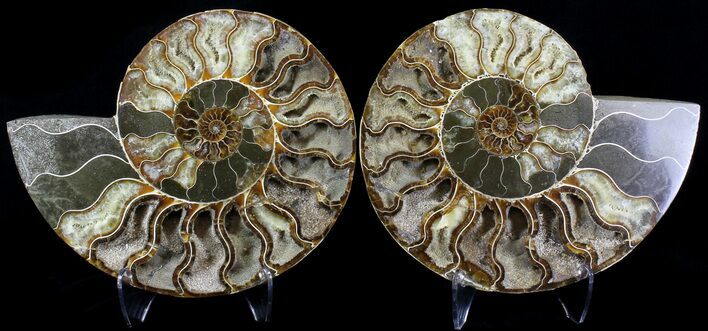This Specimen has been sold.
8.35" Wide Split Ammonite Pair - Crystal Pockets
Here is a huge cut and polished Cleoniceras ammonite fossil from the Cretaceous of Madagascar. It exhibits gorgeous mineralization within the chambers, each separated by white calcite scepta (divisions). The reverse side has a very beautiful, mother of pearl look to it. This highly polished, exotic ammonite makes a superb display piece with tremendous historical appeal.
It comes with a pair of display stands. There is a repaired crack through the piece but it is barely visible from the display side.
It comes with a pair of display stands. There is a repaired crack through the piece but it is barely visible from the display side.
About Ammonites
Ammonites were predatory, marine mollusks that thrived during the Paleozoic and Mesozoic eras, particularly in the Jurassic and Cretaceous periods, before going extinct around 66 million years ago. These creatures are characterized by their coiled, spiral shells, which resemble the modern-day nautilus. Ammonite shells were divided into chambers; as they grew, they built new chambers and sealed off the old ones. These chambers were filled with gas, which helped them control buoyancy in the ocean.
The outer shell of ammonites often displays intricate ribbed or ridged patterns and their fossils sometimes show a wide range of beautiful colors due to mineralization over time. The shells fossilized well, making ammonites abundant in the fossil record.. In addition to being popular in fossil collections, ammonites are valuable in geological studies, as they serve as index fossils, helping scientists date rock layers and understand the Earth's prehistoric environments.
Ammonites were predatory, marine mollusks that thrived during the Paleozoic and Mesozoic eras, particularly in the Jurassic and Cretaceous periods, before going extinct around 66 million years ago. These creatures are characterized by their coiled, spiral shells, which resemble the modern-day nautilus. Ammonite shells were divided into chambers; as they grew, they built new chambers and sealed off the old ones. These chambers were filled with gas, which helped them control buoyancy in the ocean.
The outer shell of ammonites often displays intricate ribbed or ridged patterns and their fossils sometimes show a wide range of beautiful colors due to mineralization over time. The shells fossilized well, making ammonites abundant in the fossil record.. In addition to being popular in fossil collections, ammonites are valuable in geological studies, as they serve as index fossils, helping scientists date rock layers and understand the Earth's prehistoric environments.
SPECIES
Cleoniceras
LOCATION
Ambatolafia, Mahajanga Province, Madagascar
SIZE
8.35" Wide
CATEGORY
SUB CATEGORY
ITEM
#30166
We guarantee the authenticity of all of our specimens.
 Reviews
Reviews












